Since the 15th century, the word “marquise” has been used to refer to folding metal awnings and fabric awnings, the design of which was developed by the Marquis Francesco Borgia. Thus, he protected his beloved from the rays of the scorching sun. Since then, marquises have become a sign of respectability, comfort and coziness. Their practicality and ease of use were highly appreciated by the owners of private houses and cottages.
Classification and purpose
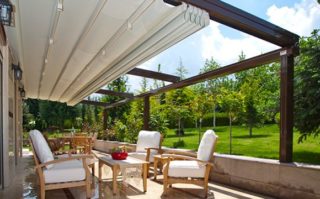
In general, a terrace awning is a canopy, the working surface of which can be extended, lowered, tilted. The design is in many ways similar to indoor roller blinds, only awnings are intended for outdoor use. The fabric base is impregnated with a special composition, so they do not fade in the sun, do not get wet in the rain, and reflect about 90% of the sun's rays. The structures are designed for long-term operation.
Varieties of awnings:
- horizontal;
- vertical;
- radius;
- balcony;
- pergola.
The horizontal awning is a fabric sliding awning, which is usually used in suburban houses, restaurant terraces, street cafes, etc. They are attached to the facades of various buildings, at the same time being installed in a horizontal position.
Vertical sliding awnings structurally resemble horizontal awnings, but are located vertically on the facades of buildings.
With the help of radius awnings, you can equip complex multifaceted structures, for example, tents, tents, etc.
Balcony awnings are located on the walls or ceilings of the balconies. With their help, you can well cover the balcony from the scorching rays of the sun.
Pergola awnings differ from other types by the presence of vertical supports that allow you to push the awning over a long distance.
There is another type of marquise with the original name "marisolette". Designed exclusively for shading windows and is often used in private cottages, holiday homes, offices, etc. The rigid fastening of the awning frame along the window opening makes it practically invulnerable to strong gusts of wind, therefore it is installed on the windward side of the building.
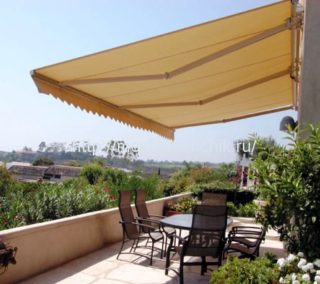
Rolled awnings can be:
- cassette;
- semi-closed;
- open.
In open types, the shaft with the web is attached to the wall of the building and is not protected by anything from atmospheric precipitation.
The semi-closed type of awning is a C-shaped case, in which a roller with a fabric is placed. However, in this case, all brackets are located outside and are also exposed to atmospheric precipitation.
The cassette-type awnings are equipped with a special sealed cassette cover, in which all the components of the mechanism are hidden. The cover is made of durable plastic, impervious to changes in weather conditions.
The principle of operation of roll-lever structures
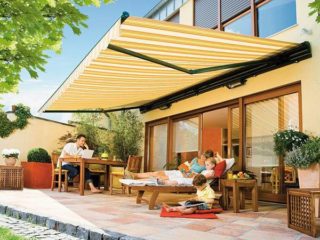
The most common models are retractable terrace awnings (otherwise - elbow) awnings. The design of such models, assembled from folding brackets (elbows), provides an extension of the awning to the required distance. In this case, horizontal retractable structures are equipped with two or more levers and a shaft with fabric.The opening levers operate the folding arms that pull the fabric canopy with them. In the opposite direction, the levers move under the action of a rotating shaft and pull the fabric with them, winding it into a roll.
When the lever-roll system is equipped with vertically fixed elements, the size of the extended panel is determined by the length of the open brackets. Additional lateral fastening of such systems makes them resistant to wind loads.
Most often, terrace-type lever-roll systems do not have side fastening, which negatively affects their wind resistance. In addition, the linear attachment of the awning with a large awning width requires additional fixation along the wall. As such an attachment, you can use anchoring with screws for each meter of the structure or vertical metal posts, which are attached to the floor through support plates to give the structure more rigidity.
The reliability of the terrace structures largely depends on the load on the lever-roll mechanism. For example, a canopy with a width of 6 to 12 m will require four arms.
The principle of operation of the roll-lever mechanism of the marisolette is somewhat different from other awning designs. This is due to the fact that with its help the fabric awning should be lowered or raised only in the vertical direction. Structurally, it consists of an upper part, which is installed above the window opening and ensures the movement of the fabric along it. In addition, special brackets are fixed on the sides of the window opening, allowing the lower part of the awning to deviate from the vertical position by an angle of about 120-150 °. In this case, a visor is formed, thanks to which daylight enters the room unhindered, while protecting it from sunlight.
One of the advantages of the marisolette is the ability to adjust the length of the component parts. The maximum extension of the visor can be up to 2.75 m.
Materials used in the manufacture of terrace awnings
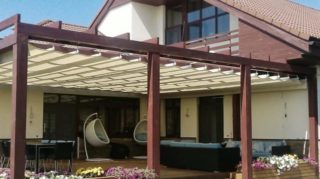
Terrace awnings are a combined device, in the manufacture of which a variety of materials can be used:
- steel;
- aluminum;
- cermets;
- technical (awning) fabric;
- plastic, etc.
Also, in the production process of the parts that make up the terrace awnings, a variety of chemical products are used: anti-corrosion and decorative coatings, impregnating compounds, enamels, paints, etc.
Details of the roll-link mechanisms
The details of the mechanisms that ensure the operation of the retractable roof for the terrace are made of steel and aluminum alloys. When special rigidity is needed (cardan shaft, brackets, etc.), stainless or galvanized steel is used for manufacturing, in others (guides, frontal beam, etc.) - aluminum alloys.
To reduce the cost of production, parts made of copper-based cermets are often used. But such designs, as a rule, do not last long, the warranty period of products in general rarely exceeds 12 months.
Metal parts of open and semi-open awnings must be made of materials that do not corrode or have an anti-corrosion coating.
Fabrics for awnings
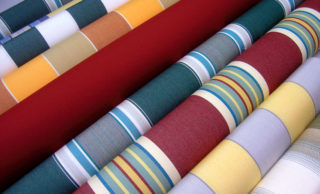
With a few exceptions, awnings and terrace awnings are fabric awnings that protect people underneath from the scorching sun. At the same time, for use as awning coverings, special technical fabrics are used, which in themselves are a high-tech material. They have high requirements regarding waterproofness, durability, water and dirt repellency. They must withstand maximum tensile loads and have high color fastness.
The surface of the Sunsilk SNC (swela nano clean) fabric is covered with the smallest crystals, due to which dirt particles are less attracted to its surface than water. As a result, the water stream flowing over the surface of the awning washes away dirt on its own.
The use of an electric drive to control the awning mechanisms led to the fact that the fabric began to be in a state of constant tension. In turn, this contributed to the deterioration of the properties of the fabric surface of the awning. To extend the service life of the awning cover, many manufacturers have switched to an innovative technology of gluing instead of the traditional sewing of fabric panels. It allowed:
- increase the seam density of the canvases when joining them;
- eliminate premature aging of the seam due to exposure to temperature;
- evenly distribute the breaking forces over the entire plane of the joint;
- to exclude abrasion of threads on the metal parts of the awnings.
An equally important property of modern awning coverings is their varied color palette. When direct sunlight hits the surface of the fabric, the effect of luminescence appears, which makes it more comfortable for people to be under the awning.
Design and construction of a terrace awning
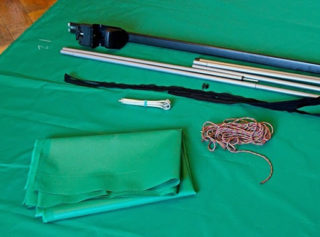
Structurally, a retractable roof for a terrace is quite simple to manufacture, it is not difficult to make it with your own hands. You will need to purchase the necessary materials and have a set of tools at hand.
Arrangement of the awning begins with the development of a schematic drawing of the entire structure. Should be considered:
- the width of the awning;
- the distance from the wall to the farthest point of extension of the awning;
- distance from the floor to the upper and lower suspension points;
- estimated dimensions of the awning.
Having developed a diagram of the proposed design, you need to purchase all the necessary materials: fabric, material for the frame, folding mechanism, fasteners.
For the manufacture of the frame of the roll-over canopy, aluminum pipes are best suited. They are able to withstand the required load and at the same time do not corrode. If necessary, you can also use wood, but in this case, the service life of the structures will be short-lived.
After acquiring all the necessary units and parts, they begin to assemble the frame. Then the fabric canvas of the awning is cut out. The folding mechanism is mounted on the wall and synchronizes its operation with the frame and fabric.








